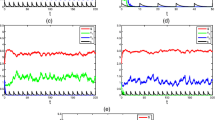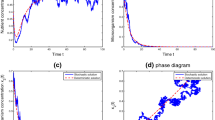Abstract
Both uniform persistence and the existence of periodic coexistence state are established for a periodically forced Droop model on two phytoplankton species competition in a chemostat under some appropriate conditions. Numerical simulations using biological data are presented as well to illustrate the main result.
Similar content being viewed by others
References
Cushing, J.M., 1980. Two species competition in a periodic environment. J. Math. Biol. 10, 385–400.
Cushing, J.M., 1984. Periodic two-predator, one-prey interactions and the time sharing of a resource niche. SIAM J. Appl. Math. 44, 392–410.
DiToro, D.M., 1980. Applicability of cellular equilibrium and Monod theory to phytoplankton growth kinetics. Ecol. Model. 8, 201–218.
Droop, M.R., 1968. Vitamin B12 and marine ecology. IV. The kinetics of uptake, growth, and inhibition in Monochrysis ltheri. J. Mar. Biol. Assoc. UK 48, 689–733.
Droop, M.R., 1973. Some thoughts on nutrient limitation in algae. J. Phycol. 9, 264–272.
Grover, J.P., 1991. Non-steady state dynamics of algal population growth: experiments with two chlorophates. J. Phycol. 27, 70–79.
Grover, J.P., 1992. Constant- and variable-yield models of population growth: responses to environmental variability and implications for competition. J. Theor. Biol. 15, 409–428.
Lenas, P., Pavlou, S., 1995. Coexistence of three competing microbial populations in a chemostat with periodically varying dilution rate. Math. Biosci. 129, 111–142.
Morel, F.M., 1987. Kinetics of nutrient uptake and growth in phytoplankton. J. Phycol. 23, 137–150.
Nisbet, R.M., Gurney, W.S.C., 1982. Modelling Fluctuating Populations. Wiley, New York.
Pascual, M., 1994. Periodic response to periodic forcing of the Droop equations for phytoplankton growth. J. Math. Biol. 32, 743–759.
Smith, H.L., 1997. The periodically forced Droop model for phytoplankton growth in a chemostat. J. Math. Biol. 35, 545–556.
Smith, H.L., Waltman, P., 1994. Competition for a single limiting resource in continuous culture: the variable yield model. SIAM J. Appl. Math. 54, 1113–1131.
Smith, H.L., Waltman, P., 1995. The Theory of the Chemostat. Cambridge University Press, New York.
Wolkowicz, G., Zhao, X.-Q., 1998. N-species competition in a periodic chemostat. Differ. Integral Equ. 11, 465–491.
Zhao, X.-Q., 1996. Asymptotic behavior for asymptotically periodic semiflows with applications. Commun. Appl. Nonlinear Anal. 3, 43–66.
Zhao, X.-Q., 2003. Dynamical Systems in Population Biology. Springer, New York.
Author information
Authors and Affiliations
Corresponding author
Additional information
Research supported in part by the NSERC of Canada and the MITACS of Canada.
Rights and permissions
About this article
Cite this article
White, M.C., Zhao, XQ. A Periodic Droop Model for Two Species Competition in A Chemostat. Bull. Math. Biol. 71, 145–161 (2009). https://doi.org/10.1007/s11538-008-9357-7
Received:
Accepted:
Published:
Issue Date:
DOI: https://doi.org/10.1007/s11538-008-9357-7




